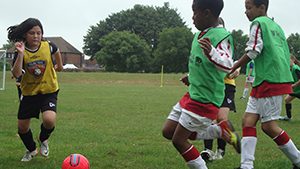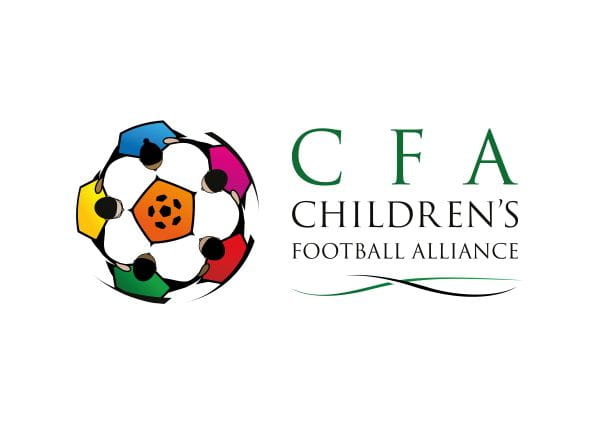 With the World Cup kicking off in Russia, it won’t be long before football mania sweeps the country once again. The tournament represents the peak of achievement in the sport, but everyone has to start somewhere. It’s easy to forget that every footballer started off with a love of the game that began, usually, in childhood.
With the World Cup kicking off in Russia, it won’t be long before football mania sweeps the country once again. The tournament represents the peak of achievement in the sport, but everyone has to start somewhere. It’s easy to forget that every footballer started off with a love of the game that began, usually, in childhood.
The development and health benefits of football are wonderful for children. Playing encourages a healthy lifestyle and helps to keep children active. If they find the sport enjoyable, they’ll want to do it even more. Even at an early age, between 3 and 6, just kicking a small ball around in the house (child and ball proofed) or in the park can help with co-ordination and motor skills. When playing with other children, team work, social skills and communication are essential and can be developed.
Joining a local team can be a good idea as it can help to teach the fundamentals of the game and can hone skills, as well as creating bonds between team mates. Not only can it help social skills but it can create a bond between parent and child by sharing an activity that they both enjoy. Playing football competitively has its merits, but sometimes the expectations of professional football can filter down into the grassroots football. Additional pressure, a must win mindset, and over-zealous parents can make the game appear daunting for some children.
Whilst the idea of jumpers for goalposts is often written off as misty-eyed nostalgia, it’s actually the free-for-all games that children start and curate that create a love of the game. There are no substitutions, goalkeepers are rotated, teams can be any size, there are no referees and children self-regulate their own games. Children tend to pick sides based on ability, but everybody does get to play which allows those who might not be particularly skilled a chance to play and get better and if the teams are unbalanced, they will get mixed up to make for a closer game. Jameel Hadi, lecturer in Social Work at Salford University discovered that children’s expectations from the game centred around involvement whereas adults concentrate more on results and winning.
Removing adults from the game allows children to make their own rules, set their own boundaries and develop their sense of fair play on their own terms.
Primary Times spoke with Paul Cooper and Rick Fenoglio, the brawn and brains behind Give Us Back Our Game. Paul is now a Director of The National Children’s Football Alliance an organisation that is gaining an international reputation delivering football projects for children outside the radar of association football.
Paul is now a Director of The National Children’s Football Alliance an organisation that is gaining an international reputation delivering football projects for children outside the radar of association football.
Paul and Rick told us: “On the green where we did the Give Us Back Our Game stuff on the estate, there were over 100 kids involved. For the rest of the week – it was empty. The space was there, but it’s getting that mindset together where families go out, or a couple of families get together and take 10 kids and they’ll have fun. It’s about grassroots, neighbourhoods and community. Just getting back to the game. It’s encouraging people to do it themselves, rather than having organised things everywhere. People tend to think that they don’t have the skills to organise it, or permission to do it. Sometimes it gets a bit blurred. If I get my friend’s son and my son to go down the park do I need a CRB (Criminal Records Background Check)? What happens if someone breaks a leg? It’s all those kinds of things. You don’t need a CRB!
One of the best things we did with Give Us Back Our Game was when we went to Battersea Park. We just put up pitches. We started with one pitch. First a couple of boys came along, then a girl joined us, and it built up. Then we put up another pitch and filled that. In the end we had 9 pitches and word got around…it was one of the best days.
We had older kids and younger kids. You’d think that it’d be unfair, but what happened was, the younger kids learned from the older kids in terms of what they’re doing and their skills and the older kids became mentors. So, they start coaching and they feel good about showing the younger ones what to do. Automatically they become like kids and if you don’t have a referee, they referee themselves. One of the tricks for parents or teachers trying to implement something like this is to be slow to react. If the kids make a change or want to do something just let it happen. There is a balance to be struck. If things do get out of hand, which they very rarely do, then there’s an adult there to step in. “
It’s worth remembering Bobby Charlton’s words on the England side that won the World Cup in 1966, “the World  Cup was not won on the playing fields of England, it was won on the streets.” By encouraging children to enjoy the game freely the seeds could be sown for the next World Cup Winning side.
Cup was not won on the playing fields of England, it was won on the streets.” By encouraging children to enjoy the game freely the seeds could be sown for the next World Cup Winning side.
Jumpers For Goalposts.
Is it nostalgia? Possibly, but these versions of football still exist up and down the country and allow children to simply enjoy playing with their friends and develop their skills. Here’s our favourite football inspired games to play until it gets dark and you have to go in for your tea or someone takes the ball home in a huff.
Football.
Seems obvious, but of course this version is completely different to anything FIFA could come up with. Rush and spider goalies, 20 a side (sometimes more, sometimes fewer), no positions, anything for goalposts, imagined crossbars, and “next goal wins” regardless of the score. Some might argue that there’s no chance of developing skill in these conditions, but the reason such games are remembered so fondly by those of us now in adulthood is that they were such good fun.
World Cup – Wembley – Cuppies
One keeper and any number of players trying to score against them. Once you’ve scored, you’re through to the next round. The last person to score is knocked out. These rounds continue until the “final” when two players remain. The problem with this version of the game comes when you’ve dribbled the ball around everyone and scored a peach of a goal, then have to spend 20 minutes waiting for the round to finish. This leads to people missing on purpose to begin with. The doubles version of the game meant that passing was as important as dribbling, and you wouldn’t be on your own for 20 minutes waiting for someone else to score. Often adapted to prevent goal-hanging to include an imagined six-yard box that you can’t score from if you’re inside it. This itself can lead to heated debate!
Headers and Volleys
Trying to score a scorpion kick goal on an asphalt tennis court or tarmacked carpark is inadvisable but smashing a thunderous volley (like David Platt’s in Italia 90) into the net/neighbour’s garden is beyond satisfying. Basically, someone crosses the ball, then the striker volleys or heads it into the goal…develops passing and ball control skills, and of course, goal celebration technique.
Football Tennis
Tennis, but with football. Can be played between two people or more. The net can be anything from an actual tennis net, if you’re lucky, or a bit of old rope strung across the centre of the “court”. A “set” usually goes to 11 points but can go upto 15:14 once you get to tie-break territory. Develops ball control and possible interest in tennis.
Crossbar Challenge
Works best with two teams (or else you’ll be forever fetching the ball). Using a single set of goal posts, a team on each side, each player attempts to hit the crossbar. If you hit it, you score a point and get another go. First to 11 wins.
Develops accuracy and a tendency to hit the crossbar in the penalty shootout of important semi-finals (probably).
Wally – Rebound – Wall Ball
Using a large wall, preferably with no windows, the first player kicks the ball against the wall, the second attempts to return it – but with only one touch. You can let the ball stop, but if the first player has smashed it, you’ll be miles away. Using playground furniture as obstacles adds to the tactics. This can also be adapted to hit a specific area of the wall (a square drawn on with chalk for example) and points are awarded accordingly.
Develops first touch, tactics, and accuracy.
